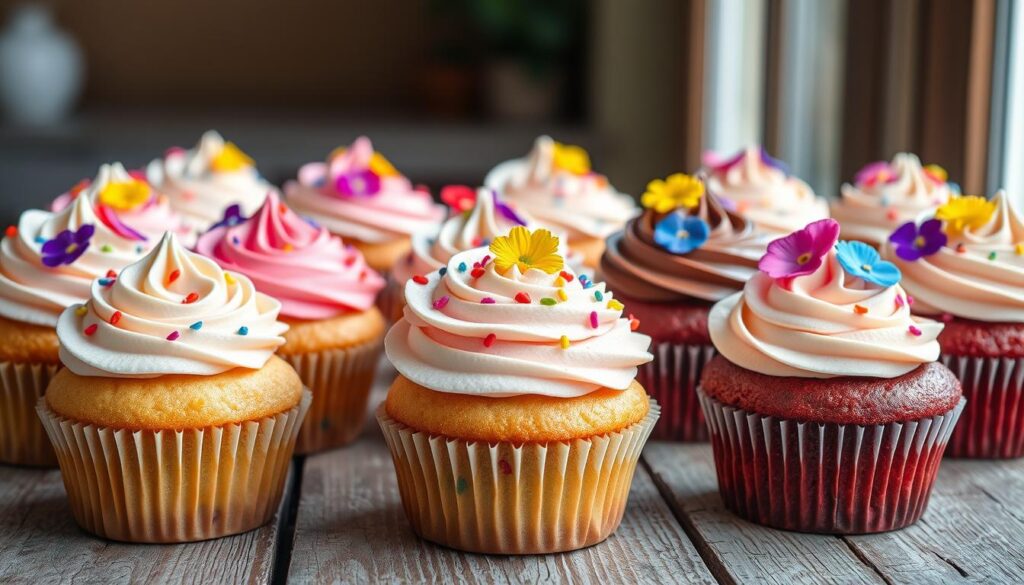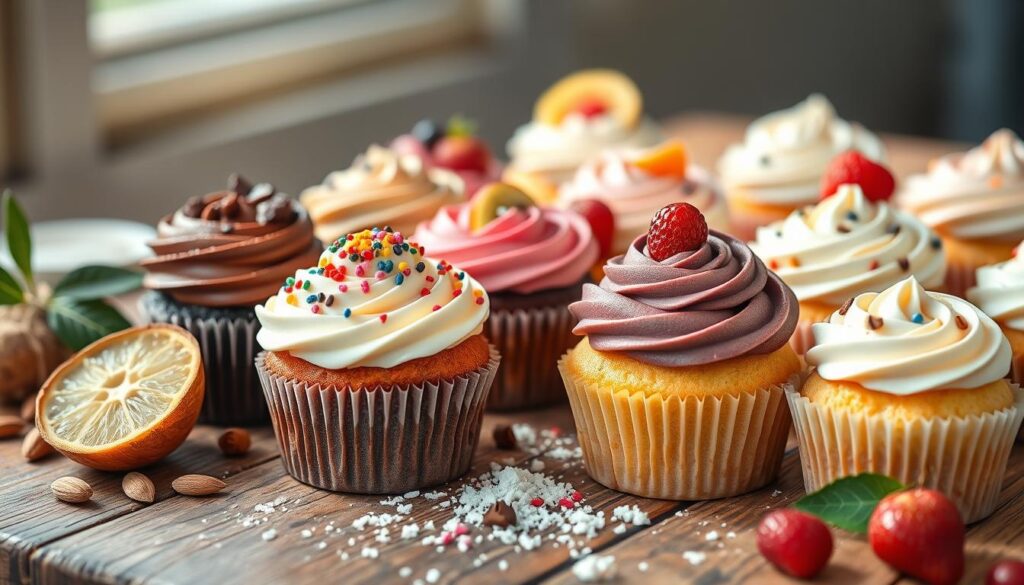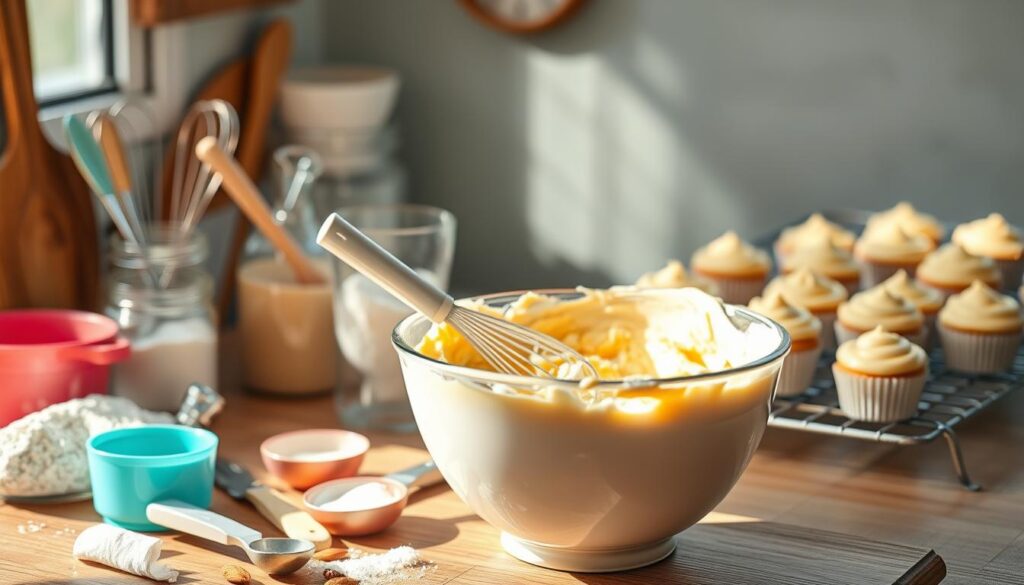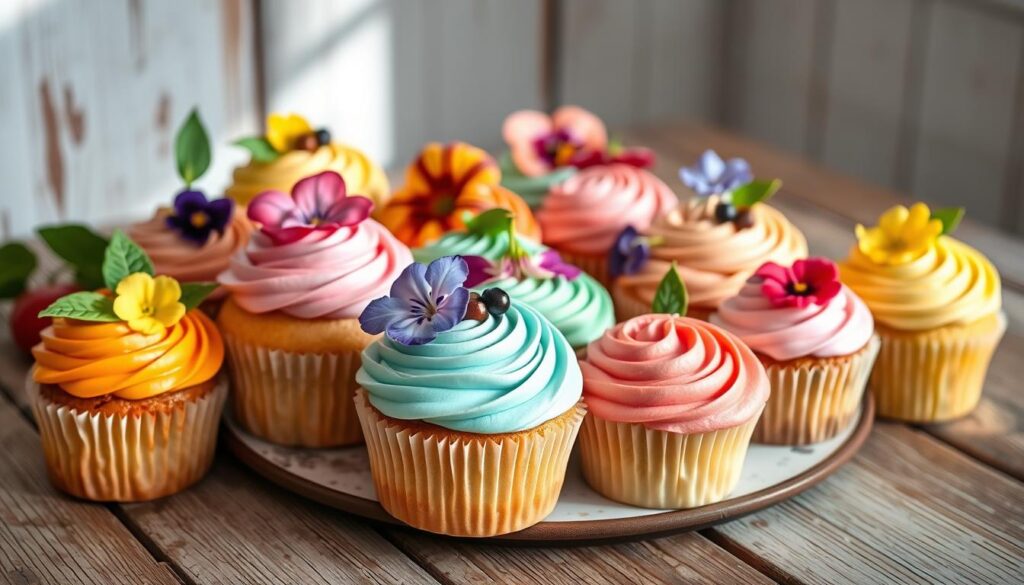Exploring gluten free cupcakes means you’ll need to tweak traditional recipes. This ensures the right texture and taste. With more people looking for gluten free options, learning these skills can boost your baking skills. Start with a gluten free cupcake recipe.

These tips will help you make gluten free cupcakes that are just right. Whether you’re new to baking or have experience, making gluten free cupcakes is rewarding. Use a gluten free cupcake recipe to bake tasty treats.
- Gluten free cupcakes require modified traditional recipes
- Mastering gluten free baking techniques can expand your repertoire
- A gluten free cupcake recipe is a great place to start
- Texture and flavor are key in gluten free cupcakes
- Gluten free baking can be a rewarding experience
- Using the right gluten free cupcake recipe is essential
Understanding Gluten Free Cupcake Basics
Baking gluten free cupcakes requires knowing the basics of gluten-free baking. Traditional wheat flour can’t be replaced with other flours easily. This is because gluten-free flours don’t have the same structure and binding properties as gluten. This difference can change the texture and consistency of your gluten free cupcakes.
Choosing the right flour is key. Options include almond flour, coconut flour, and rice flour. Each flour has its own needs and effects on your cupcakes. For example, almond flour makes cupcakes denser because of its high fat content. Coconut flour, on the other hand, absorbs more liquid than regular flour.
Exploring gluten-free baking also means looking at your equipment. A digital scale, a stand mixer, and measuring cups are important. They help improve the quality of your gluten free cupcakes. Also, knowing the right temperature is critical. This includes the temperature of your ingredients and the accuracy of your oven. Both can affect your cupcakes’ texture and consistency.
Why Traditional Flour Alternatives Matter
Traditional flour alternatives try to mimic wheat flour but can be pricier. They might not give the same texture and structure. But, they’re good for beginners. As you get better at gluten-free baking, try different flours and mixes to find what works best for you.
Best Flour Blends for Gluten Free Cupcakes
Choosing the right flour is key for gluten free cupcakes. A good recipe mixes flours for structure, texture, and taste. You can pick pre-made blends or mix your own for cupcake baking.
Flours like rice, almond, and coconut are popular for gluten-free baking. Each flour changes the taste, texture, and nutrition of your cupcakes. Rice flour is light, almond flour is nutty, and coconut flour is high in fiber.
To balance your gluten free cupcake recipe, mix different flours. Here are some ratios:
- 1 cup rice flour, 1/2 cup almond flour, 1/4 cup coconut flour
- 1 cup almond flour, 1/2 cup coconut flour, 1/4 cup rice flour
- 1 cup coconut flour, 1/2 cup rice flour, 1/4 cup almond flour
Experimenting with flour combinations is the secret to great gluten free cupcakes. With practice, you’ll make moist and tasty cupcakes that everyone will enjoy.

Using the right flours and a good recipe, you can make beautiful gluten-free treats. Whether you’re new to baking or experienced, gluten-free baking offers endless fun and creativity.
| Flour Type | Characteristics | Ratio |
|---|---|---|
| Rice Flour | Light, delicate | 1 cup |
| Almond Flour | Rich, nutty | 1/2 cup |
| Coconut Flour | High in fiber, protein | 1/4 cup |
Essential Ingredients That Make Perfect Gluten Free Cupcakes
When baking gluten free cupcakes, the right ingredients are key. You want them to be moist and flavorful, just like regular cupcakes. Focus on xanthan gum, moisture-adding ingredients, and natural flavor enhancers.
Xanthan gum is vital for gluten and dairy free cupcakes. It helps with texture and consistency, making them light and fluffy. You can also use guar gum or cornstarch for the right texture.
Xanthan Gum and Binding Agents
Ingredients like applesauce or yogurt keep your cupcakes moist and delicious. They prevent dryness and add sweetness. Honey or maple syrup can also enhance flavor and texture.
Moisture-Adding Components
Flavor enhancers like vanilla or almond extract are also important. They add a rich taste to your cupcakes. These ingredients make your gluten free cupcakes perfect for any event or just for fun.

Using these ingredients, you can make moist and delicious gluten free cupcakes. They’re great for any occasion, whether it’s a special event or just for fun.
| Ingredient | Function |
|---|---|
| Xanthan gum | Binding agent |
| Applesauce | Moisture-adding ingredient |
| Vanilla extract | Natural flavor enhancer |
Mixing Techniques for Light and Fluffy Results
Baking the perfect gluten free cupcake requires the right mixing technique. You aim for a light and fluffy texture, which can be tricky with gluten-free ingredients. Start by alternating between dry and wet ingredients. This helps avoid overmixing and ensures your batter is well mixed.
A stand mixer can be very helpful in mixing. It makes the process efficient and thorough. But, don’t overmix, as it can make your gluten free cupcakes dense and gummy. Mix just until the ingredients come together smoothly. You can also add air by folding in whipped cream or beaten eggs.
Here are some tips for mixing your gluten free cupcake batter:
- Use room temperature ingredients for smooth mixing.
- Avoid overmixing to prevent tough and dense cupcakes.
- Add air by gently folding in whipped cream or beaten eggs.

By following these tips and using the right mixing techniques, you can make light and fluffy gluten free cupcakes. Be gentle when mixing your batter. Don’t hesitate to try different techniques until you find what works best for you.
| Mixing Technique | Benefits |
|---|---|
| Alternating dry and wet ingredients | Prevents overmixing and ensures well-incorporated batter |
| Using a stand mixer | Efficient and thorough mixing, with less risk of overmixing |
| Incorporating air into the batter | Creates light and fluffy texture, with a tender crumb |
Common Mistakes to Avoid When Baking Gluten Free Cupcakes
Baking gluten free cupcakes can be tricky. It’s easy to make mistakes that change the taste and texture. To get the best results, you need to measure carefully, control the temperature, and test your cupcakes right.
Gluten free cupcakes need more care than regular ones. Measuring ingredients accurately is key because gluten-free flours are denser and more sensitive to liquids. A digital scale helps you get the right measurements, which is important for success.

- Use a mix of gluten-free flours for the right texture and taste.
- Keep an eye on your oven temperature to avoid overbrowning or underbaking.
- Check if your cupcakes are done by looking at the edges and center. The edges should be lightly golden, and the center should be firm.
By avoiding common mistakes, you can make delicious gluten free cupcakes. Be patient and flexible, as gluten free baking can take practice. With time, you’ll get better at making gluten free cupcakes that are just as good as the traditional ones.
Decorating Your Gluten and Dairy Free Cupcakes
Decorating gluten and dairy free cupcakes opens up a world of possibilities. You can use gluten-free frosting recipes, with or without dairy. For a dairy-free frosting, coconut cream or vegan butter work great.
To make your cupcakes stand out, use safe edible decorations. Some good choices include:
- Gluten-free sprinkles
- Edible glitter
- Fondant decorations
If you’re thinking about gluten free cupcake delivery, how they look matters a lot. Make sure your cupcakes look good and stay safe during transport. Use special boxes or containers for gluten and dairy free cupcakes.
Here’s a simple recipe for gluten-free frosting:
| Ingredient | Quantity |
|---|---|
| Coconut cream | 1 cup |
| Vegan butter | 1/2 cup |
| Vanilla extract | 1 teaspoon |
With a bit of creativity, you can make stunning gluten and dairy free cupcakes. They’re perfect for any event. Or, just enjoy them yourself. Gluten free cupcake delivery services are a great way to get them.
Storage Tips to Maintain Freshness
Storing gluten free cupcakes right is key to keeping them fresh. Gluten-free treats can dry out quicker than others. So, it’s important to store them properly.
You can keep them at room temperature for a day or two. But for longer, refrigeration is better. It’s great for cupcakes with creamy frostings, keeping them fresh for up to three days. Always use an airtight container to keep moisture in.
Freezing Guidelines
Freezing is also a good choice for long storage. Wrap each cupcake in plastic or foil, then in a freezer-safe bag. To serve, thaw at room temperature or microwave them. This method is ideal for storing lots of cupcakes, lasting up to two months.
By using these storage tips, your gluten free cupcakes will stay fresh longer. Whether you store them at room temperature, in the fridge, or freeze, follow the right steps. This way, they’ll stay moist and tasty.
Troubleshooting Guide for Gluten Free Cupcake Issues
Even experienced bakers can face problems with gluten free cupcakes. We’ve created a guide to help you solve common issues. You’ll learn how to fix texture problems and why your cupcakes might not rise right.
A great gluten free cupcake recipe is key to perfect texture and taste. Knowing the common problems helps you improve your recipe. This way, you can make delicious treats for everyone.
Texture Problems and Solutions
- Grittiness: This can be caused by using the wrong type of sugar or not mixing the batter properly. Try using a finer sugar and mixing the batter for a longer time to ensure all ingredients are well combined.
- Dryness: This can be caused by overbaking or using too much flour. Try reducing the baking time and using a higher ratio of liquid ingredients to flour.
- Gummy consistency: This can be caused by underbaking or using too much liquid. Try increasing the baking time and reducing the amount of liquid ingredients.
Rising and Sinking Concerns
To ensure your gluten free cupcakes rise properly, use the right leavening agents and don’t overmix. If they sink, it might be due to overbaking or too much sugar. Try different recipes to find the best one for you.
| Issue | Cause | Solution |
|---|---|---|
| Grittiness | Wrong type of sugar or inadequate mixing | Use finer sugar and mix batter for a longer time |
| Dryness | Overbaking or too much flour | Reduce baking time and use higher ratio of liquid ingredients to flour |
| Gummy consistency | Underbaking or too much liquid | Increase baking time and reduce amount of liquid ingredients |
Conclusion: Mastering the Art of Gluten Free Cupcakes
Baking gluten free cupcakes is a bit tricky, but it gets easier with practice. You’ll soon make moist, fluffy treats that are just as good as regular cupcakes. Try different gluten free flour mixes to find your favorite. Don’t hesitate to add nuts, citrus zest, or natural sweeteners for extra flavor.
If you’re thinking about starting a gluten free cupcake business, now is a great time. More people are looking for safe, healthy treats. Your gluten free baking skills could help you build a successful business.
Keep trying new things and enjoying the baking process. The joy of making delicious gluten free cupcakes is worth all the effort. Happy baking!
FAQ
What makes gluten-free cupcakes different from traditional cupcakes?
Gluten-free cupcakes need special ingredients and methods to get the right texture. You can’t just replace wheat flour with gluten-free flours. They behave differently in baking.
You’ll need to mix the right flour blends, use binding agents, and follow specific mixing methods. This way, you can make gluten-free cupcakes that are light and fluffy.
What are the best flour blends for gluten-free cupcakes?
The best flour blends for gluten-free cupcakes often include rice flour, almond flour, and coconut flour. You can also use pre-made gluten-free flour blends. The goal is to find a mix that gives structure, moisture, and flavor like traditional cupcakes.
What ingredients help bind and add moisture to gluten-free cupcakes?
Ingredients like xanthan gum, applesauce, and yogurt are key for gluten-free baking. Xanthan gum helps replace gluten’s structure-building properties. Moisture-adding ingredients prevent dryness.
Natural flavor enhancers like vanilla extract can also help. They make up for any taste differences in gluten-free flours.
How does the mixing technique affect gluten-free cupcakes?
Proper mixing is vital for the right texture in gluten-free cupcakes. Overmixing can make them dense and gummy. Undermixing can cause uneven baking.
Using a stand mixer and alternating between dry and wet ingredients helps. This method incorporates air and makes the cupcakes light and fluffy.
What are some common mistakes to avoid when baking gluten-free cupcakes?
Accurate measuring, controlling temperature, and testing for doneness are key. Gluten-free flours need precise measurements. Issues like over-browning or underbaking can happen easily.
Traditional toothpick tests may not work well. You’ll need to find other ways to check if your cupcakes are fully baked.
How can I decorate gluten-free and dairy-free cupcakes?
There are many ways to decorate gluten-free and dairy-free cupcakes. You can use gluten-free frosting recipes made with coconut cream or vegan butter. Piping techniques and edible decorations safe for gluten sensitivities can make your cupcakes look great.
How should I store gluten-free cupcakes to maintain freshness?
Storing gluten-free cupcakes properly is important. They can dry out faster than gluten-containing ones. You need to find the right balance between room temperature and refrigeration.
Freezing techniques can also help for long-term storage.
If you want know how to make Bow Arrow Cupcakes Recipe clike here 👈👈

